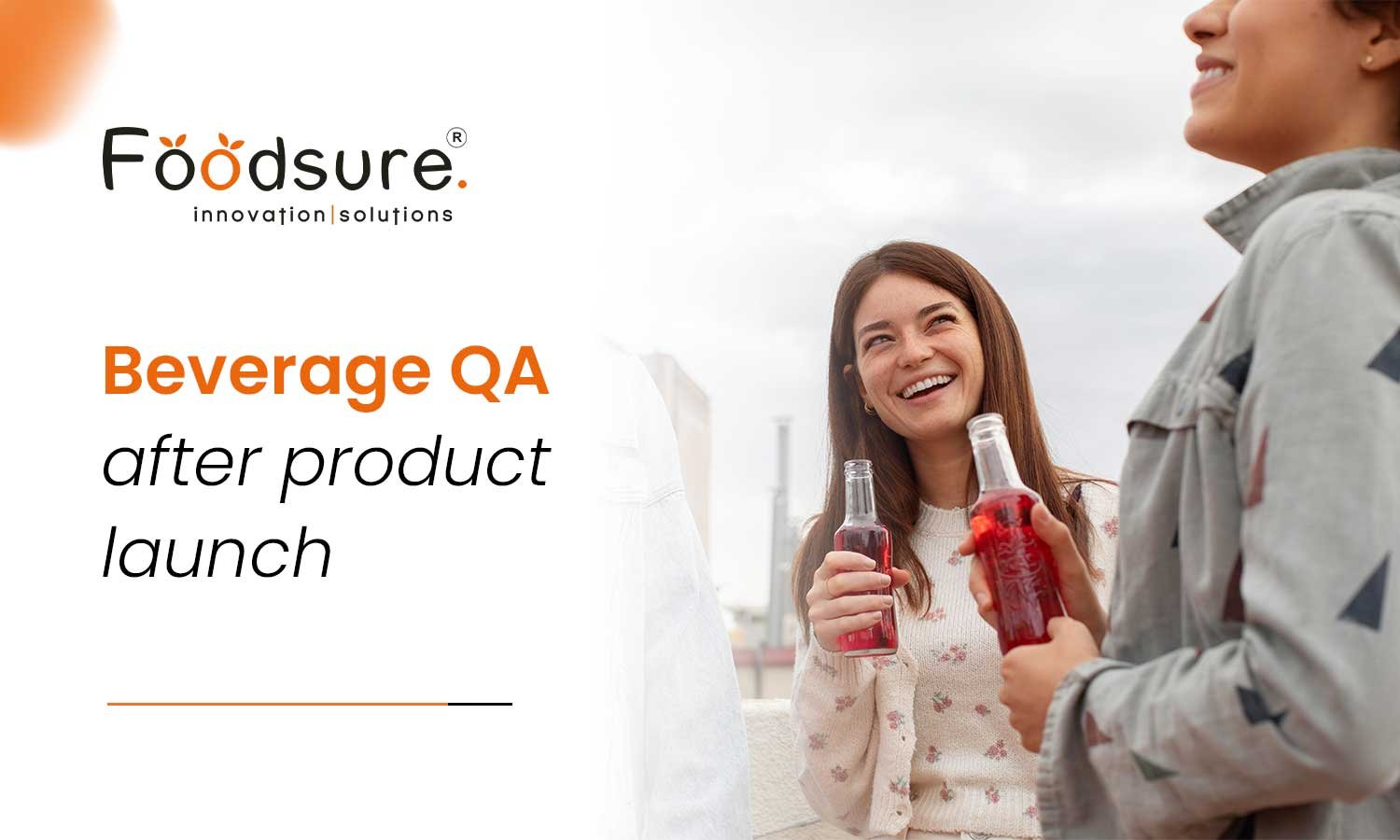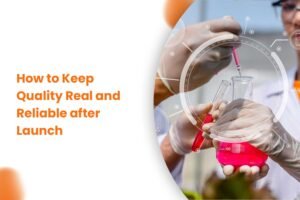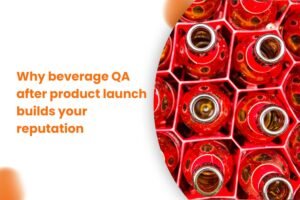It’s fun to launch your drink, but the truly hard work begins once your beverage is on the shelf. Once it is out in the world, your beverage will go through fluctuating temperatures, long shipping routes, store mishandling, and the effects of time itself. Beverage QA after product launch is what protects your brand during this critical time. Without a plan, you have left quality to chance, and that is a chance that you cannot afford to take.
In the U.S., food and beverage recalls increased by around 8% in 2023. Other data shows FDA and USDA recalls rose over 20% between 2020 and 2023. While many recalls result from human errors or microbial issues, nearly 30% involve quality or processing failures—the exact share traced directly to post-launch quality revelations isn’t publicly confirmed.
Let’s get into the discussion of how to monitor beverage quality after launch.
How to Keep Quality Real and Reliable after Launch
So, how do you monitor drink quality after launch when your bottles are spread across the country or globally?
1. Check what’s happening on shelves, not just in labs
Lab tests are useful, but they don’t reveal how your drink performs on a dusty store rack in the upcoming 6 months. That’s why beverage QA after product launch is a must. Observe your product in real life: is it leaking? Is the label faded? Is the colour off? You’d be surprised at how much you can catch simply by visiting stores.
Fact that blows your mind: A broad consumer survey found that about 54% of people said they’d stop using a brand after just one bad experience. While not specific to beverages, it’s a strong reminder, every drink matters.
2. Use tech that tells you the truth
IoT sensors allow tracking of temperature and humidity for transportation and storage, and they help brands quickly identify problems with shipments. Poor handling and/or storage are highly risk factors in the beverage industry (and many perishable goods) for spoilage. Real-time alerts from IoT systems allow you to rectify problems before they get to customers.
Your Post-Launch Quality Process Matters More Than You Think
Let’s discuss what a reliable beverage quality assurance process looks like after launch. It’s not a one-size-fits-all system, but here are the essentials for the beverage industry.
Sensory testing at regular intervals
Test the taste, smell, and appearance of your drink from different regions or cities. Major brands like Coca-Cola and Nestlé conduct blind taste tests every 2 to 3 weeks. This helps them identify inconsistencies quickly, before customers notice.
Collect feedback like it’s gold.
Customer complaints are not just something to brush off; they’re often quiet warnings. If a few people mention the drink feels “flat,” it’s probably more than a one-off. Maybe something’s off in your carbonation during bottling.
Make it easy to track what people are saying, whether it’s in a review, a DM, or a call to your helpline. When people feel ignored, they stop coming back. Beverage QA after product launch is not just about fixing problems; it’s also about showing customers you’re listening and that their feedback matters.
Keep an eye on shelf life.
Don’t assume that your shelf life test from the R&D stage will last indefinitely. Real-world conditions vary. If you’re using fresh ingredients, natural preservatives, or live cultures like kombucha, retest every few months.
Smart Ways to Monitor Beverage Quality after Launch without Going Crazy
Managing all this may feel overwhelming, but it doesn’t have to be. Below are the important key factors about how to monitor beverage quality after launch. Here’s how growing brands make it work.
1. Combine systems so that everything talks to each other
When your ERP software tracks production and your QA software tracks feedback, you can see the full picture. If a batch from your Punjab plant receives more complaints, you’ll notice it sooner.
2. Assign a small “quality squad”
Select 2 to 3 people from different teams, QA, operations, and customer service, and have them meet monthly to review post-launch data. They’ll catch problems early. You don’t need a large team; you just need a focused one.
3. Chemical and Nutritional Analysis
Verify the beverage’s ingredient composition, nutritional content, pH level, sugar (Brix), alcohol content (if applicable), and check for contaminants like heavy metals or pesticide residues using standardized laboratory methods.
4. Train your distributors, too
Up to 15% of beverage quality loss happens due to cold chain failures during distribution. Logistics issues are a key cause of drink complaints. Your drink may leave your plant in perfect condition, but still arrive at the customer’s compromised condition. That’s why Beverage QA after product launch must include oversight beyond your facility. Educate your transporters and warehouse partners on proper storage and handling. A simple visual guide can go a long way in preventing damage during transit.
5. Continuous Visual Inspections
Regularly examine the appearance of finished products for color, clarity, particulate matter, and packaging defects before distribution.
Traceability isn’t optional; it’s your safety net.
Let’s talk about beverage product traceability after launch. If something goes wrong, can you trace it in hours, or does it take days? This is a helpful section for the beverage industry.
Use batch codes that make sense.
The code on your bottles should identify how, when, and where they were produced. If you have cause to complain or an issue arises, you must be able to quickly trace its source.
Try QR codes for better control.
QR codes don’t just help with marketing; they can link directly to production data. Customers can scan to get the original information. You can scan to trace batch movement. This benefits both sides.
Fun fact: Coca-Cola employs social media sentiment analysis to track drink quality post-launch. Monitoring real-time customer feedback online means they can detect issues like an off-taste or a packaging defect well in advance of a traditional complaint received in customer service.
Practice a mock recall every 6 months.
Yes, practice. Run a pretend scenario where one batch is spoiled. How quickly can your team isolate it, alert partners, and stop further issues? If it takes more than 24 hours, you need to improve your system.
In one case study, a mid-sized juice brand lost ₹3.5 crore in sales during a real recall because they couldn’t trace the bad batches promptly. That’s a lesson you don’t want to learn the hard way.
Why beverage QA after product launch builds your reputation
Beverage QA after product launch protects your brand, not just your product. It helps you deliver on the promises made on the label every time someone opens a bottle. It’s also crucial for growth. When customers trust that your drink tastes as good in week 12 as it did on launch day, they’ll come back.
That’s how real loyalty is generated. Loyal customers don’t just repurchase; they also make exceptions and forgive a one-time mistake. It’s still one-time unless they know you care about quality. Whatever you’re launching – a fizzy soft drink, a plant-based smoothie, or a premium energy drink; consistency is all-in-all. That’s nothing more than the beverage QA after product launch, and that should be part of whatever you are doing.
Formulation Is Just the Start. Foodsure Stays With You After Launch
Trust Foodsure for your beverage brand and innovation. We don’t stop at formulation. We help you monitor your beverage product post-launch to ensure shelf stability, taste consistency, and consumer trust.
This is the right time to book your free consultation. Contact us today at +91 8130404757
FAQs
1. How often should I check drink quality after launching my product?
Every 2 to 3 weeks, conduct sensory tests and shelf-life checks. Increase the frequency if you’re using fresh or sensitive ingredients.
2. What tools help monitor drink quality after launch?
Use a combination of QA software, ERP systems, and physical audits. Consider adding IoT sensors if you’re shipping sensitive beverages like cold-pressed juice.
3. What is beverage product traceability after launch, and why does it matter?
You can trace every bottle back to its original batch. This helps you respond quickly in the event of complaints or product issues.
5. What if I see a drop in quality in one region only?
This often indicates distribution or storage problems. Check handling conditions at warehouses or during transport in that specific area.





